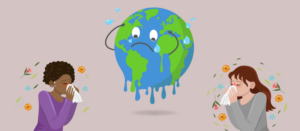
Until this month, I only associated the word ‘bootleg’ with the era of ‘Prohibition’ (of alcohol) during the ‘Roaring Twenties’ (1920s) and with a quarterback play during football games. However, historians and those with allergies and asthma will record and remember this month for the ‘Bootleg Fire’—named for the location in Oregon—Bootleg Spring– that is one of the recent 80 major wildfires in 13 states in our country and 800 wildfires in the western provinces of Canada.
The smoke has drifted eastward and affected the lung function of those living on the East Coast—from Maine southward to Washington D.C—who are predisposed to reacting strongly to pollutants. An animated daily time course map between June 25 and July 26 shows how the smoke plumes were carried by wind currents and largely bypassed the Midwest.
Map: Watch July’s wildfire smoke travel across the country (nbcnews.com)
The reason given for the increase in spontaneous wildfires is climate change. According to an ongoing temperature analysis at NASA’s Goddard Institute for Space Studies, the average global temperature has increased by 1.2 degrees Celsius (2.18 degrees Fahrenheit) since 1880—the early years of the Industrial Revolution. Two-thirds of this warming has occurred since 1975. The temperature curve result is reproducible….as shown in the map in the link below that was measured by other organizations—the Met Office Hadley Centre in the United Kingdom, the National Oceanic and Atmospheric Administration and the Berkeley Earth research group.
World of Change: Global Temperatures (nasa.gov)
The increased atmospheric temperature is considered to be the effect of using fossil fuels—coal and oil –that emit greenhouse gases, which are mainly carbon dioxide, methane and nitrous oxide. These gases absorb the infrared energy that would normally reach outer space from the Earth’s surface. The gases then trap the infrared energy in the atmosphere and radiate some of it back to the Earth’s surface to make the surface hotter. As the warmer temperature causes water to evaporate and to dry out the wood in the forests, the wood becomes susceptible to burning from either more heat or another source such as lightening.
There has been ample published observational evidence to support a link between changes in the world’s climate and the prevalence of allergic conditions. Among them are the following:
- Ragweed pollen production rises in environmentally controlled greenhouses with increasing temperature and increasing carbon dioxide in the air [Ann Allergy Asthma Immunol 2002]
- When compared to a surrounding rural environment, urban Baltimore had higher temperatures, greater carbon dioxide levels and faster growth of ragweed plants with greater pollen production [J Allergy Clin Immunol 2003]
- In Europe, a trend of increasing amounts of pollen was greater in urban areas of 13 countries when measured for intervals ranging from 10 years to 28 years between 1977 and 2009 [Public Library of Science One 2012]
- Distribution changes in trees have occurred, as evidenced by photos from 21 sites in northeast Kansas between 1956 and 1996 showing conversion of native tallgrass prairie into red cedar forests [Ecosystems 2002]
- An increase in carbon dioxide concentration from 400 to 800 parts per million leads to increased mold species growth on plants [J Exp Bot 2009]
Another such study appeared earlier this year in the esteemed journal Proceedings of the National Academy of Sciences. The authors showed, from pollen records of 60 North American cities during the years 1990-2018, that the mean annual temperature was the strongest predictor of pollen counts from among eight climate variables. They also found over these 28 years that there were increases in pollen concentration by 21% and longer pollen seasons that started about 20 days earlier. The most pronounced effects were seen in Texas, the Midwest and the Southeast. The effects were less obvious in the northern United States, including the Great Lakes states. Tree pollen, compared to grass and weed pollens, had the greatest increase.
It’s difficult to discount the existence of climate change when we see with our own eyes that glaciers are melting in Glacier National Park. The commonly used expression “We are our own worst enemy” may be derived from the nihilistic philosopher Friedrich Nietzsche (not someone I particularly care to quote) who wrote: “But the worst enemy you can meet will always be yourself.” I’d rather frame the choices we have to make—–whether it be to control a rising global temperature or to control the spread of the Delta variant of the novel coronavirus Sars-CoV-2—–from one of my favorite lines of literature in Shakespeare’s Julius Caesar: “Men at some time are masters of their fate. The fault, dear Brutus, is not in our stars, But in ourselves….” We need to solve a problem by looking at the most relevant reproducible observations, accepting them and creating solutions that are focused and feasible.
The last 18 months have been most disruptive for all of us to varying degrees. We want what we have been comfortable with. We do not want a shock to our systems. However, change—in the words of our 35th President of the United States John F. Kennedy—“is the law of life and those who look only to the past or present are certain to miss the future.” Let’s hope that we have the insight, patience and humility to craft workable methodical solutions that use the best of the past.
Dr. Klein